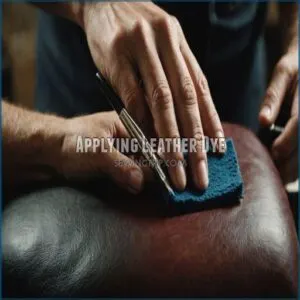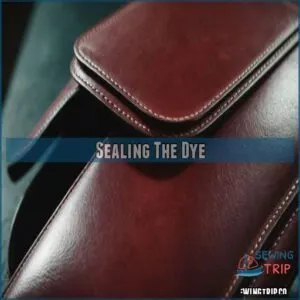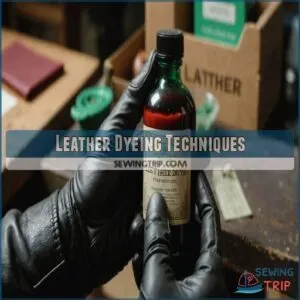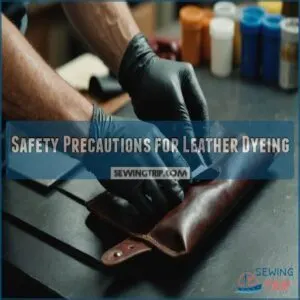This site is supported by our readers. We may earn a commission, at no cost to you, if you purchase through links.
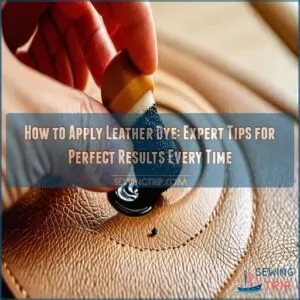 You’ll need patience and precision to apply leather dye like a pro.
You’ll need patience and precision to apply leather dye like a pro.
Start by cleaning your leather thoroughly and stripping any existing finish.
When you’re ready to dye, work in thin, even layers using circular motions with a sponge or wool dauber.
Think of it like painting a masterpiece – you can’t rush perfection.
Apply light pressure to help the dye penetrate, and let each coat dry completely.
After 2-3 coats, buff the surface and seal it with a leather finisher.
The secret to a flawless finish lies in the details of your preparation and technique.
Table Of Contents
- Key Takeaways
- Preparing Leather for Dyeing
- Choosing The Right Leather Dye
- Applying Leather Dye
- Drying and Conditioning The Leather
- Sealing The Dye
- Leather Dyeing Techniques
- Common Leather Dyeing Mistakes
- Caring for Dyed Leather
- Safety Precautions for Leather Dyeing
- Advanced Leather Dyeing Techniques
- Frequently Asked Questions (FAQs)
- Conclusion
Key Takeaways
- You’ll need to thoroughly clean and strip any existing finish from the leather before dyeing – skipping preparation will lead to patchy, uneven results.
- Apply the dye in thin, even coats using circular motions with a wool dauber or sponge, letting each layer dry completely for 24-48 hours to ensure proper absorption.
- You must protect yourself by wearing nitrile gloves, an apron, and working in a well-ventilated area since leather dyes contain strong chemicals.
- After dyeing, you’ll need to condition the leather and apply a sealer to lock in the color and protect it from wear – expect the entire process to take several days for the best results.
Preparing Leather for Dyeing
You’ll need to get your leather ready before you even think about reaching for that dye bottle, just like you wouldn’t paint a wall without cleaning and priming it first.
Before you start the transformation process, you’ll want to clean the surface thoroughly, remove any old finishes, protect those metal parts, and put on your safety gear to keep your hands and clothes dye-free.
Cleaning The Leather
Before diving into your leather dyeing project, you’ll need to properly clean the surface. Think of it like prepping a canvas – the cleaner your starting point, the better your results will be.
- Use a soft brush to remove loose dirt and debris
- Wipe down with a damp cloth to lift surface grime
- For tough stains, apply saddle soap leather cleaner with gentle circular motions
- Apply saddle soap with gentle circular motions
- Let the leather dry completely at room temperature
- Test the surface by running your finger across it – it should feel smooth and clean
Removing Old Finishes
Most leather items have a factory finish that’ll block your dye from properly penetrating.
Grab a quality deglazer and apply it with circular motions using a lint-free cloth.
You’ll know you’re done when the surface looks matte and slightly rough.
If the finish is stubborn, try acetone as a last resort, but test it first in an inconspicuous spot.
Protecting Metal Parts
Metal parts on your leather items can turn into a real headache if dye seeps onto them.
Start by covering all buckles, snaps, and zippers with masking tape, pressing down firmly on the edges to prevent seepage.
For tricky spots like rivets, cut small circles of tape slightly larger than the metal surface.
Remember to wrap tape around stitching areas where metal components meet leather.
Wearing Protective Gear
Now that your metal parts are covered, let’s keep you safe while working with leather dye. You’ll need proper gear to protect yourself from stains and fumes.
Here’s what experienced leather crafters always wear:
- Two pairs of nitrile gloves – because dye-stained hands aren’t a good look
- A chemical-resistant apron – saves your favorite clothes
- Safety goggles and a respirator mask – your eyes and lungs will thank you
Don’t skip these basics – they’re your best defense against accidents.
Choosing The Right Leather Dye
You’ll need to pick the right type of leather dye before you start your project, as each kind offers different benefits for your specific leather item.
Whether you’re working with a soft leather jacket or a sturdy pair of boots, your choice between water-based, alcohol-based, or oil-based dyes will make a big difference in your final results.
Types of Leather Dyes
From basic water-based options to professional-grade solutions, leather dyes come in several varieties to match your project needs.
Let’s break down the main types you’ll encounter:
| Dye Type | Penetration | Durability | Best For |
|---|---|---|---|
| Alcohol-based | Deep | High | Firm leather |
| Oil-based | Very deep | Excellent | All leather |
| Water-based | Moderate | Good | Soft leather |
| Low VOC | Light | Fair | Indoor projects |
Remember, each type brings its own strengths to the table, so you’ll want to pick one that fits your specific needs.
Selecting The Right Color
Color selection is your key to a successful leather project.
You can explore various leather dye colors on websites like leather dye colors to find the perfect shade for your project.
Start by testing your dye on a hidden spot – you’d be surprised how different colors can look on leather versus the bottle.
For the best results, check color charts and current trends to guide your choice.
If you’re after a custom shade, try blending different dyes, but always mix enough for your entire project to maintain consistency.
Considering Leather Type
Different leather types need specific dye approaches.
Veg-tan leather readily absorbs dye, making it perfect for custom coloring.
Check the grain pattern and thickness – full-grain leather takes dye beautifully, while suede needs special care, and always prep the leather with a suitable product before applying dye.
Finished leather might resist standard dyes, so you’ll want to remove the finish first.
If you’re working with chrome-tanned leather, stick to surface finishes rather than penetrating dyes.
Applying Leather Dye
You’ll need a steady hand and some patience to transform your leather with the perfect dye application.
With the right tools and technique, you can create an even, professional-looking finish that’ll make your leather items look brand new.
Using an Applicator
Selecting the right applicator can make or break your leather dyeing project.
Think of it as choosing the perfect paintbrush for a masterpiece.
You’ll want a tool that feels comfortable in your hand and gives you total control over the dye application.
- A wool dauber lets you work the dye into every nook and cranny
- Foam brushes help achieve streak-free coverage
- Spray bottles offer quick, even application for large areas
- Clean cotton rags give you maximum control for detailed work
Remember to clean your applicator between uses to prevent color mixing and maintain its performance.
Applying Multiple Coats
Now that you’ve got your applicator ready, let’s build up that perfect color depth.
Multiple coats are your best friend when it comes to achieving a rich, even finish.
Just remember – patience pays off here.
To make sure you’re using the right tools for the job, consider investing in a high-quality leather dye applicator tool.
| Coat Number | Drying Time | Color Intensity | Next Steps |
|---|---|---|---|
| First | 30 mins | Light | Check evenness |
| Second | 1 hour | Medium | Test absorption |
| Third | 2 hours | Deep | Assess coverage |
| Final | 24 hours | Rich | Start finishing |
Dyeing Techniques
Mastering key techniques, such as using thick needles when sewing through leather, is crucial for achieving professional-looking results. The perfect leather dye application comes down to mastering a few key techniques.
You’ll get the best results using a wool dauber for even coverage, while airbrush dyeing works wonders for large areas.
When working with unusual materials, consider using techniques like preparing wood for fabric dye, which prioritize sanding with fine-grit sandpaper for a smooth surface.
Try sponge application for a softer look, or edge dyeing with a small brush for precise details.
For advanced projects, experiment with color blending and gradient dyeing using multiple layers.
Avoiding Common Mistakes
Learning from others’ mistakes can save your leather project.
After mastering different dyeing methods, you’ll want to avoid these common pitfalls:
- Rushing through prep work leads to patchy results
- Oversaturating leather causes warping and stiffness
- Skipping patch tests risks color bleeding disasters
- Using incompatible finishes ruins the final look
Take your time and remember: most leather dyeing mishaps come from impatience rather than lack of skill.
Drying and Conditioning The Leather
You’ll need to let your newly dyed leather dry completely for at least 24 hours in a well-ventilated space before moving on to conditioning.
Once it’s fully dry, you’ll want to apply a leather conditioner evenly across the surface to keep your leather soft and prevent it from becoming stiff or cracking.
Natural Drying Methods
After you’ve applied the dye, patience becomes your best friend.
Place your leather piece in a well-ventilated spot away from direct sunlight, where air can circulate freely.
Room temperature (around 72°F) with low humidity works best.
You’ll want to let it sit undisturbed for at least 24 hours.
During this time, check occasionally to make sure it’s drying evenly.
Using a Hairdryer
While a hairdryer can speed up leather drying, you’ll need to be careful with the settings.
Keep it on low heat and hold it about 6 inches away from the surface.
Move it constantly in circular motions to prevent heat damage.
Using a hairdryer for drying is similar to using a heat gun to remove creases from leather shoes.
Most leather types can handle this treatment, but check your specific leather’s care instructions first.
A 15-minute session should do the trick.
Conditioning The Leather
Once your leather is dry, it’s time to lock in that gorgeous color with a good conditioning.
Pick an oil-based conditioner that matches your dye type – this prevents any unwanted reactions.
Apply it in gentle circular motions using a soft cloth, working from edge to edge.
Don’t rush this step; your leather needs time to drink in the moisture.
Let it rest for 12-24 hours.
Buffing The Leather
The secret to professional-looking leather is a proper buffing technique.
Take your soft cloth and work in small, circular motions to bring out that beautiful shine.
You’ll know you’re doing it right when the leather starts to warm up under your hands.
- Start with gentle pressure in the center, gradually working outward
- Use a clean microfiber cloth for best results
- Buff until you achieve an even, natural-looking sheen
Sealing The Dye
You’ll want to seal your freshly dyed leather to lock in that beautiful color and protect it from daily wear and tear.
Once you’ve chosen the right leather sealer, you can apply it evenly with a clean applicator, making sure to cover every inch of the surface for lasting protection.
Choosing a Leather Sealer
After conditioning your leather, selecting the right sealer locks in that perfect dye job.
Here’s what you need to know about popular sealers:
| Sealer Type | Best For | Durability |
|---|---|---|
| Carnauba Wax | Light use items | 3-6 months |
| Resolene | Heavy wear goods | 1-2 years |
| Acrylic Finish | Accessories | 6-12 months |
Pick a sealer that matches your leather type – natural waxes work great for wallets, while synthetic sealers shine on boots and bags.
Applying The Sealer
Now that you’ve picked your sealer, applying it correctly will lock in that perfect dye job.
Start by testing the sealer on a small hidden spot – you’ll thank yourself later.
Using smooth, even strokes, work the sealer into your leather with a clean cloth or applicator pad.
Keep your coats thin and uniform, working in one direction.
Let each coat dry completely before adding another layer.
Buffing The Leather Again
Once your leather sealer has fully dried, grab your buffing cloth for that final polish.
Here’s how to get that showroom shine:
- Move in small circles with firm, steady pressure
- Pay extra attention to any dull spots or uneven areas
- Keep buffing until you see a consistent sheen across the surface
Pro tip: Use an old cotton t-shirt as your buffing cloth – it’s perfect for creating that smooth, professional finish you’re after.
Leather Dyeing Techniques
You’ll find that applying leather dye isn’t a one-size-fits-all process, as you can choose from several reliable methods including wool daubers, brushes, rags, or dipping techniques.
Whether you’re working on a small wallet or a large couch, each technique offers unique advantages that’ll help you achieve the perfect color and finish you’re looking for.
Wool Dauber Method
Why do leather crafters swear by the wool dauber method.
This tried-and-true technique gives you perfect control over dye application, a key step before moving on to leather sewing techniques.
Dip your dauber in the dye, tap off excess, and work in small circular motions.
Keep your strokes even and overlapping for consistent coverage.
For better results, apply light coats and let each layer dry before adding more.
Brush Application
For brush application, choosing the right brush is key to achieving that perfect leather dye finish.
Pick a high-quality natural or synthetic brush that matches your project size.
Before applying leather dye, make sure to pre-wash and dry the leather to achieve the best results, just like preparing fabric for dyeing.
- Start with light, even strokes going in one direction
- Keep your brush clean between coats to prevent streaking
- Load your brush consistently – not too much, not too little
- Work in small sections to maintain control
Overlap your strokes slightly to avoid missed spots, and maintain steady pressure throughout the application.
Rag/Cloth Method
Looking to master the rag/cloth method for leather dyeing? Start with a clean, lint-free cloth—old t-shirts work great.
Here’s a quick guide to different cloth types and their effects:
| Cloth Type | Coverage | Best For |
|---|---|---|
| Cotton T-shirt | Even, smooth | Large areas |
| Microfiber | Ultra-smooth | Detailed work |
| Terry cloth | Textured | Antiquing effects |
| Cheesecloth | Light, gradual | Color building |
| Chamois | Deep penetration | Final buffing |
Dip your cloth in dye, wring out excess, then work in circular motions for streak-free results.
Pulling and Dipping Methods
The pulling and dipping methods offer you complete control over leather dye consistency.
Dipping works best for uniform pieces, while pulling lets you maintain even color distribution across larger sections.
Here’s what you need to know:
- Heat your dye bath to 72°F for best penetration
- Dip smaller items fully for 30 seconds
- Pull larger pieces through slowly, maintaining tension
- Repeat process for darker shades, letting each layer dry
Common Leather Dyeing Mistakes
You’ll save yourself time and money when you learn from the common mistakes that can turn your leather dyeing project into a muddy mess.
Even experienced crafters sometimes skip essential steps like proper preparation or drying time, but you won’t make these errors after reading this section.
Inadequate Preparation
Skipping proper prep is like trying to paint a wall without cleaning it first – you’re setting yourself up for trouble.
Don’t rush through cleaning and deglaze your leather thoroughly.
Check for surface contamination that’ll block dye absorption.
Make sure you’ve picked a dye that’s compatible with your leather type.
And always dampen the surface evenly – dry spots will create patchy results that’ll drive you crazy.
Insufficient Drying Time
Rushing the drying process can turn your leather project into a total mess.
When you don’t give each coat enough time to dry, you’ll end up with dye streaks and uneven color that’s nearly impossible to fix.
Think overnight drying between coats is overkill? Think again.
Moisture trapped beneath the surface can lead to cracking and color fading later on.
Plus, rushing often causes leather stiffness that’s tough to remedy.
Incorrect Sealer Application
Many DIY leather projects hit a snag at the sealing stage, turning a beautiful dye job into a sticky mess. You’ll want to avoid these common sealer slip-ups that can ruin your hard work:
- Applying sealer before the dye’s completely dry
- Using the wrong type of sealer for your leather
- Putting on too thick a coat
- Not testing the sealer on a scrap piece first
- Rushing the application instead of working in thin, even layers
Caring for Dyed Leather
You’ll need to give your freshly dyed leather items regular care to keep them looking their best and prevent color fading.
With the right maintenance routine and protective measures, you can extend the life of your dyed leather and maintain its rich, vibrant color for years to come.
Maintenance Tips
Anyone can keep their dyed leather looking fresh with proper maintenance.
Regular care helps prevent wear and extends the life of your leather pieces.
Here’s what you need to know:
| Care Task | Frequency | Products Needed | Tips |
|---|---|---|---|
| Dust removal | Weekly | Soft cloth | Gentle circular motions |
| Conditioning | Monthly | Leather conditioner | Apply thin, even coat |
| Deep cleaning | Quarterly | Leather cleaner | Test in hidden spot |
| Protection | Biannually | Leather protector | Avoid direct sunlight |
Redyeing Leather
Sometimes your favorite leather items need a fresh coat of dye.
Before you start redyeing, make sure to test the new color on a hidden spot to avoid surprises.
Clean thoroughly and strip the old finish for best results.
- You’ll feel like a pro when your old jacket looks brand new again
- There’s nothing better than saving money by redyeing instead of replacing
- You’ll love showing off your restored leather to friends
Follow up with a good conditioner to keep that new color looking sharp and vibrant.
Avoiding Damage
Keep your dyed leather away from harsh sunlight to prevent fading and cracking.
Don’t let water pool on the surface – it’ll create unsightly spots and weaken the dye bond.
Regular conditioning helps maintain the leather’s flexibility and color depth.
Watch out for oils and chemicals that could strip the dye.
When storing, use breathable covers rather than plastic, and keep items in a cool, dry place with good air circulation.
Safety Precautions for Leather Dyeing
You’ll need more than just your creative spirit when working with leather dyes, as these powerful chemicals require proper safety gear and good ventilation to protect your health.
Before you start transforming your leather piece, make sure you’ve got your gloves, protective apron, and a well-ventilated workspace ready to go.
Protective Gear
Safety isn’t just a buzzword when you’re dyeing leather – using the right techniques, like those that involve Rit Coffee Paint Stain, can also be your shield against stains and chemicals.
You’ll need two pairs of chemical-resistant gloves to protect your hands, plus a sturdy apron to keep your clothes dye-free.
Don’t forget eye protection to guard against splashes.
A quality respirator mask with organic vapor cartridges is essential too – those leather dyes pack quite a punch in the fume department.
Working in a Well-Ventilated Area
Now that you’ve got your safety gear ready, let’s get your workspace set up for dyeing leather. Working in a well-ventilated area isn’t just about opening a window – it’s about creating a safe zone for your creative work.
- Set up a fan to direct fumes away from your workspace
- Choose a garage or outdoor space when possible
- Install a ventilation system for regular dyeing projects
- Position yourself upwind from the dye application area
Avoiding Skin Contact
With leather dye‘s stubborn staying power, protecting your skin is essential.
Double up on nitrile gloves and wear long sleeves to avoid those telltale purple hands that’ll have people wondering if you’re part of a secret art collective.
| Protection Level | What to Wear | Why It Matters |
|---|---|---|
| Basic | Nitrile Gloves | Prevents immediate staining |
| Medium | Double Gloves | Extra barrier protection |
| Advanced | Full Arm Guards | Complete coverage solution |
Advanced Leather Dyeing Techniques
You’ll discover how to mix custom colors and create unique finishes that’ll make your leather projects stand out from the crowd.
Whether you’re working with different types of leather or want to experiment with layering techniques, these advanced methods will help you achieve professional-looking results.
These results will impress even seasoned craftspeople.
Mixing Custom Colors
Ready to create your perfect leather color?
Start by understanding basic color theory – mixing primary dyes like yellow, red, and blue to achieve secondary colors.
Test your combinations on scrap leather first, noting the ratios used.
Remember that leather dyes blend differently than paint, so start with small amounts and gradually adjust.
Keep a color chart handy to track your successful mixes for future projects.
Creating Unique Finishes
Creating unique leather finishes lets you express your artistic side while adding value to your projects.
You’ll find endless possibilities for customization, from antiqued edges to metallic highlights.
Here’s how to achieve distinctive looks:
- Layer different colored dyes for a gradient effect, starting light and building depth
- Dab alcohol randomly to create distressed patterns that tell a story
- Apply metallic powders between dye coats for subtle shimmer
Dyeing Different Leather Types
Different leather types need different dyeing approaches.
Suede requires special dyes that won’t mat down its nap, while veg-tan leather drinks up dye like a sponge.
Patent leather‘s glossy finish makes it tricky to dye, but aniline leather takes color beautifully.
For coated leather, you’ll want to strip the coating first.
Think of each leather type as having its own personality – some are shy with dye, others embrace it.
Frequently Asked Questions (FAQs)
What is leather dyeing?
Leather dyeing transforms raw hide into vibrant, personalized pieces through specialized dyes that penetrate the fibers.
You’ll need to clean, prep, and seal the leather to achieve lasting, professional-looking results that won’t fade.
Can leather be dyed?
Yes, you can dye leather in various colors using alcohol-based, oil-based, or water-based dyes.
With proper preparation and technique, you’ll transform your leather items while maintaining their natural texture and durability.
How do you dye leather?
First, clean and prep your leather with a deglazer.
Apply thin, even coats of dye using a dauber or brush.
Let each coat dry completely.
Finish with leather conditioner and sealant for protection.
How do I choose a leather dye?
Consider your leather type and desired results: alcohol-based dyes penetrate deeply with vibrant colors, water-based ones are gentler, and oil-based provide rich color without drying.
Always test on a small area first.
How do you apply leather color?
After watching a friend transform his worn leather jacket, I learned the key steps: Clean the surface, apply dye evenly with a dauber or brush, let it dry, then seal with finisher for lasting color.
Is it better to dye leather wet or dry?
You can dye leather either wet or dry, depending on your needs.
Wet leather absorbs dye more evenly and deeply.
Dry leather gives you more control over color intensity and placement.
Do you oil leather before dying?
Don’t oil leather before dyeing – it’ll block the dye from penetrating properly.
Instead, clean the surface thoroughly and apply your dye directly to bare leather for the best color absorption and results.
How long to let leather dye dry before buffing?
Like a butterfly emerging from its cocoon, leather dye needs time to fully mature.
Let your dyed leather rest for at least 24 hours before buffing, flexing it occasionally during drying to prevent stiffness.
Can I dye leather shoes without removing the laces?
Remove the laces first – they’ll get in the way and likely stain.
Masking tape can be used to cover the laces completely if they cannot be removed, but know that the dye job won’t be as clean.
Will rain damage freshly dyed leather items?
Yes, rain can harm freshly dyed leather.
You’ll want to wait at least 24 hours after dyeing before exposing your items to water.
Even then, it’s best to apply a protective sealant first.
How long does leather dye typically last?
Properly applied leather dye can last 5-10 years with regular maintenance.
You’ll notice the best longevity when you’ve sealed the dye correctly and keep your leather items away from harsh sunlight and moisture.
Can leather dye stains be removed from clothing?
Ever had a leather dye mishap?
You’ll need specialized leather stain remover or rubbing alcohol to tackle those tough spots.
For delicate fabrics, it’s best to consult a professional dry cleaner right away.
Does leather dye work on faux leather materials?
Most faux leather materials won’t absorb traditional leather dyes since they’re synthetic.
You’ll need specialized vinyl or acrylic paint designed for synthetic materials instead.
These will stick better and last longer.
Conclusion
Learning how to apply leather dye takes time, practice, and attention to detail.
Once you’ve mastered the basics – from proper preparation to perfect application techniques – you’ll be ready to tackle any leather dyeing project.
Remember to work in thin layers, let each coat dry completely, and always seal your work for lasting results.
With these expert tips and a bit of patience, you’ll achieve professional-looking results that’ll make your leather pieces stand out.



